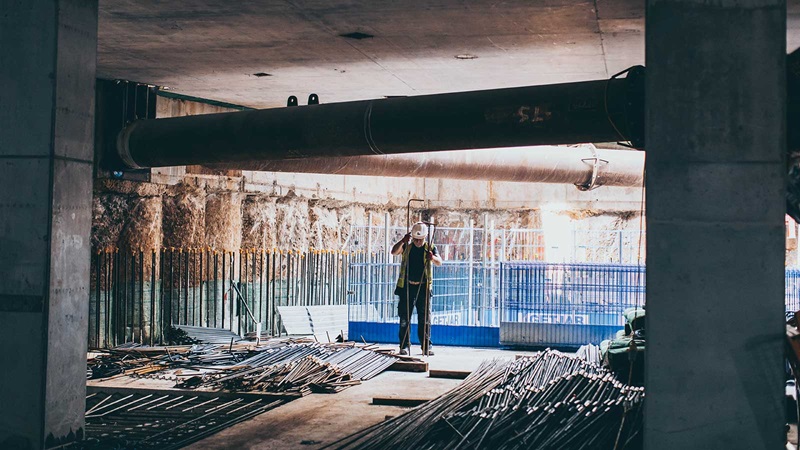Working on constrained sites - 6 steps to success
When it comes to the built environment, high volumes of traffic are a staple of the industry. On a day to day basis, huge amounts of both material and people pass through construction sites and more often than not, it is not always as simple as A to B – sometimes they move from A to B, on to C and pass through D. Sites can also be located over a significant geographical area and extend to great vertical heights, meaning not only can they be in close proximity to the general public but can also be difficult to access.
When managing this site traffic, some of the biggest difficulties that contractors can face are on sites where both space and visibility are constrained. So what can we do to set ourselves up for success? Of course, the most critical factor to consider is safety. But you already know that, with safety paramount on every site. But how can we as an industry ensure that working in challenging conditions is as efficient and straightforward as possible? Here are six key areas to take account of, to make sure you get it right the first time, and every time.
1. Delivery routes, access points, egress points and how these will be segregated from the public
On constrained sites, access and egress points are likely to be limited. The size of vehicles that can physically access the site safely may be compromised and this could lead to an increased number of smaller vehicle movements. The maximum amount of material that can physically be delivered or removed from site should be understood in detail, so that the programme accurately reflects the constraints. Delivery routes and how they can be separated from pedestrian access routes (both site-based pedestrians and the general public) must also be one of those things you should just know off the top of your head.
2. Vertical transportation of both people and materials needs careful consideration
On all sites (but particularly on high rise projects) the efficient delivery of people and materials is crucial and unless there is adequate provision for this, the programme commitments will quickly come under pressure. Take special note of the location of hoist and tower cranes as constrained sites generally limit what is possible in this regard - and getting this wrong will prove costly.
You must take into account vehicle delivery routes and vehicle / pedestrian segregation. Hoists can often be used to move materials or people and there less obvious lines of separation - compromising safety. The position of cranes and hoists and their interface with permanent works is also vital. You’ve got to think where hoists or cranes may clash with permanent structures or services and pre-empt any delay in the removal of these items. Decide whether their location will postpone the completion of any permanent works and if so, determine what the impact will be from the outset.
3. Pick points relative to hooks
Even on a constrained site it may be possible to find a location for numerous cranes or hooks. What may be less obvious is that for a hook to be fully effective it needs a dedicated pick point that can (ideally) be accessed by delivery vehicles. Given the likely limitations identified in my first point, this can often be challenging. If a project has six hooks but only three pick points then the operational effectiveness will be at least halved. Moreover, if one hook has to act as a “slave” hook to one of the others, then you could be left with double or triple handling of materials - which is both slow and inefficient.
4. A robust and clearly communicated delivery and logistics plan is essential
… and it preferably will include detailed piece counts and material movements. On a constrained site where space is limited it’s essential that deliveries spend the minimum amount of time possible on site. Unless the percentage of hook or hoist time allocated to each element of work has been reviewed, and aligned to the programme, then materials may arrive to site and be stockpiled because of insufficient means of transporting them. On a site with limited space this can cause serious issues and lead to the moving of materials multiple times. Again, not only is this inefficient, but increases the risk of safety incidents or damage.
5. Always just in time
With space at a premium, a well organised and well managed ‘just in time’ delivery protocol is essential. It requires everyone on site to be punctual while following set protocols. If absolutely necessary, consideration might be given to offsite holding areas or consolidation centres if the volume of deliveries is likely to put the ‘just in time’ delivery system under pressure. This allows you to take control of what is delivered to site and when.
6. Maximise construction to production
Every site could stand to gain from more offsite production, but on a constrained site where movement of people and materials will always be a challenge, the benefits of offsite preassembly are exponentially beneficial. Offsite preassembly leads to fewer deliveries to site, less operatives on site, less vertical and horizontal transportation, less public interface and a generally faster programme. But on a constrained site the question should always be “what can’t be pre-assembled off site?”, rather than “what can?”
The initial site design should lend itself towards construction to production rather than the site team trying to reverse engineer solutions at a later date. Trying to shoehorn the method into a site that doesn’t naturally lend itself to an offsite solution is once again, inefficient. So, if you can, get it right from the beginning.











